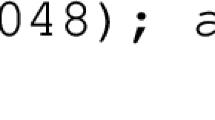Abstract
We describe an algorithm which rapidly computes the coefficients of elements of small norm in quadraticfields modulo a positive integer. Our method requires that an approximation of the natural logarithm of thatquadratic field element is known to sufficient accuracy. To demonstrate the efficiency and utility of our method,we apply it to eliminate a number of exceptional cases of a theorem of Dujella and Pethő [9]involving Diophantine triples. In particular, we are able to show that Theorem 1.2 of [9] isunconditionally true for all k ≤ 100 with the possible exception of k = 37, for whichthe theorem holds under the assumption of the Extended Riemann Hypothesis.
Similar content being viewed by others
References
C. S. Abel, Ein Algorithmus zur Berechnung der Klassenzahl und des Regulators reellquadratischer Ordnungen, Ph.D. Thesis, Universität des Saarlandes, Saarbrücken, Germany (1994).
A. Baker and H. Davenport, The equations 3x 2 z2 = y 2 and 8x 2-7 = z 2 , Quart. J. Math. Oxford Ser. (2), Vol. 20 (1969) pp. 129–137.
J. Buchmann, C. Thiel and H. C. Williams, Short representation of quadratic integers, Computational Algebra and Number Theory, Mathematics and its Applications, Vol. 325 (1995) pp. 159–185.
H. Cohen, A course in computational alegraic number theory, Graduate Texts in Mathematics, Vol. 138, Springer (1993).
H. Cohn, Advanced Number Theory, Dover Publications, New York (1980).
D. A. Cox, Primes of the Form x 2 +ny 2 , Wiley, New York (1989).
A. Dujella, On Diophantine quintuples, Acta Arith., Vol. 81 (1997) pp. 69–79.
A. Dujella and A. Pethö, A generalization of a theorem of Baker and Davenport, Quart. J. Math. Oxford Ser. (2), Vol. 49 (1998) pp. 291–306.
A. Dujella and A. Petho, Integer points on a family of elliptic curves, Publ. Math. Debrecen, Vol. 56 (2000) pp. 321–335.
A. Grelak and A. Grytczuk, On the Diophantine equation ax 2 -by 2= c, Publ. Math. Debrecen, Vol. 44 (1994) pp. 291–299.
M. J. Jacobson, Jr., Subexponential Class Group Computation in Quadratic Orders, Ph.D. Thesis, Technische Universitat Darmstadt, Darmstadt, Germany (1999).
M. J. Jacobson, Jr., Computing discrete logarithms in quadratic orders, Journal of Cryptology, Vol. 13 (2000) pp. 473–492.
M. J. Jacobson, Jr., A. Pinter and P. G. Walsh, Acomputational approach for solving y 2 = 1k +2k +·· ·+x k, submitted to Math. Comp. (2001).
The LiDIA Group, LiDIA: a c++ library for computational number theory, Software, Technische Universität Darmstadt, Germany (1997), See http://www.informatik.tu-darmstadt.de/TI/LiDIA.
P. G. Walsh, The Pell Equation and Powerful Numbers, Master' Thesis, University of Calgary, Calgary, Alberta (1988).
Author information
Authors and Affiliations
Rights and permissions
About this article
Cite this article
Jacobson, M.J., Williams, H.C. Modular Arithmetic on Elements of Small Norm in Quadratic Fields. Designs, Codes and Cryptography 27, 93–110 (2002). https://doi.org/10.1023/A:1016550519087
Issue Date:
DOI: https://doi.org/10.1023/A:1016550519087




